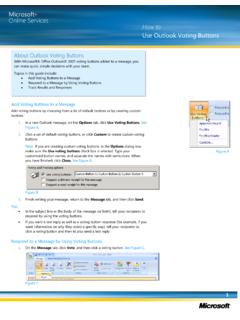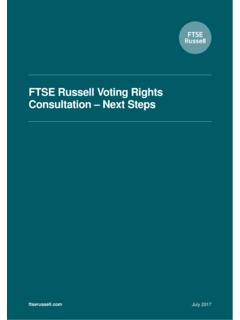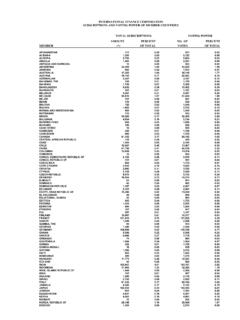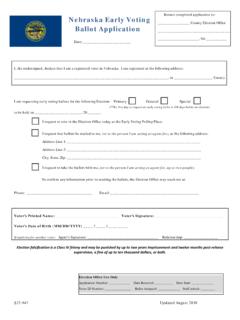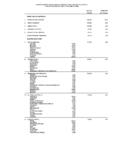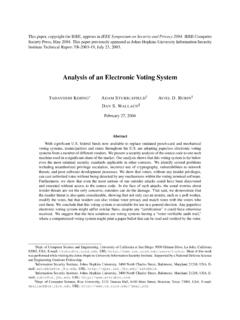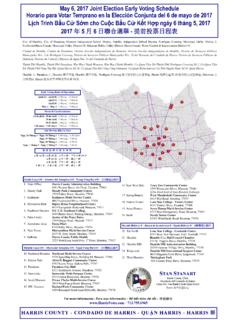Transcription of IMPORTANT VOTER INFORMATION: MUST REMAIN …
1 WHAT EVERY VOTER SHOULD KNOW Election Date: May 8, 2018 POLLING HOURS The poll s wil l be open from 7:00 through 8:00 Qualified voters standing in line at 8:00 wil l be permitted to vote. VOT ING INSTRUCTIONS Partisan Offices: Partisan primaries are held to nominate candidates to partisan offices. If a partisan primary appears on the ballot, you cannot cast vote s under both parties; you must c as t votes under one part y only. If you vote under both parties i n a partisan primary, the partisan section of your ball ot wil l not be counted. Partisan elections are held to fill partisan offices. If a partisan election appears on the ballot, you may cast a straight t icket, a split ticket or a mixed ticket. Straight Ticket: Vote the party of your choice. A vote will count for every candidate in the party s column.
2 Split Ticket: You may vote a straight ticket AND vote for individual candidates of your choice under any other party columns. Mixed Ticket: Vote for the individual candidates of your choice in each office. Candidates appearing under any party column may be selected. Nonpartisan Offices: If nonpartisan offices appear on the ballot, the offices must be voted by casting individual votes for the candidates of your choice. Avoid Overvoting : When voting the partisan and nonpartisan sections of the ballot, do not cast a vote for more candidates than are indicated under the office title. Proposals: If proposals appear on the ballot, the proposals must be voted by casting a Yes vote or a No vote on each question. IMPORTANT VOTER INFORMATION: MUST REMAIN ON DISPLAY DURING POLLING HOURS Write-in Votes: Instructions for casting a write-in vote are available.
3 If you have a question on the procedure for casting a write-in vote, ask the election workers for assistance. Ballot Secrecy: Place the ballot in the secrecy sleeve to conceal your votes before leaving the voting station; the numbered stub on the ballot must REMAIN visible. Voters Requiring Assistance: Special accommodations are available for voters who are disabled. If you require voting assistance, ask the election workers for help; a reason for the needed assistance does not have to be stated. Two inspectors will assist you in the voting station. An elector who is blind, disabled or unable to read or write may be assisted with his or her ballot by any person of the VOTER s choice, other than the VOTER s employer or agent of that employer or an officer or agent of a union to which the VOTER belongs. A specially equipped voting station is available for use by voters who are disabled.
4 The voting station permits voters who are disabled to vote independently without the assistance of another person. Spoiled Ballots: If you spoil your ballot, you may obtain a new ballot from the election workers. IMPORTANT : Persons must not intimidate, threaten or coerce any other person for registering or voting; for urging or aiding persons in registering or voting; for purposes of interfering or influencing how a person chooses to vote or not vote; or for purposes of preventing a person from voting. Election officials must not fail or refuse to permit a person to vote who is entitled to vote and must not refuse to tabulate, count and report such person s vote. ALL VOTERS MUST SATISFY MICHIGAN S VOTER IDENTIFICATION REQUIREMENT Every Michigan VOTER who offers to vote in the polls must comply with Michigan s VOTER identification requirement by showing picture identification or signing an affidavit as explained below: Voters with picture identification: Voters can satisfy the identification requirement by showing a Michigan driver s license or a Michigan personal identification card.
5 Voters who do not possess either document may show any of the following forms of picture identification as long as they are current: Driver s license or personal identification card issued by another state. Federal or state government-issued photo identification. passport. Military identification card with photo. Student identification with photo from a high school or an accredited institution of higher education. Tribal identification card with photo. Voters without picture identification: Michigan election law anticipates that not all voters will have picture identification. Voters who do not bring picture identification to the polls or do not have picture identification can vote like any other VOTER by signing an affidavit. VOTERS WHO HAVE MOVED If you are registered and 1) moved to a different precinct within the same city or township and 2) failed to change your registration address prior to the registration deadline for today s election, you are eligible to vote in today s election in the precinct where you formerly lived.
6 You will be asked to submit an address change form before you are issued a ballot. If you moved to a different city or township less than 60 days prior to today s election and failed to register to vote in your new city or township of residence by the registration deadline for today s election, you are eligible to vote in today s election in the precinct where you lived in your former city or township of residence. You will be asked to submit a registration cancellation authorization form before you are issued a ballot. If you moved to a different city or township 60 days or more prior to today s election and failed to register to vote in your new city or township of residence by the registration deadline for today s election, you are ineligible to vote in today s election. PROVISIONAL BALLOTING A VOTER whose name does not appear on the registration list can vote if the VOTER can produce a validated VOTER registration receipt dated on or before the registration deadline for the election.
7 A VOTER whose name does not appear on the registration list who cannot produce a validated VOTER registration receipt may be eligible to vote a provisional ballot. In order to obtain a provisional ballot the VOTER must: 1) complete an Application to Vote form 2) complete an affidavit stating that he or she registered to vote on or before the close of registration for the election and 3) respond to questions regarding his or her identity and residence. The election workers are responsible for providing assistance with the provisional balloting process. The answers provided by the VOTER to the identity and residence questions will determine if the ballot issued to the VOTER can be counted in the polls or must be preserved in a provisional ballot security envelope and returned to the clerk s office for review after the polls close.
8 A determination on the validity of a provisional ballot secured for later review must be rendered by the city or township clerk within six days after the election. A VOTER who is issued a provisional ballot has a right to know if his or her ballot counted. If the ballot is not counted, the VOTER has a right to know the reason. A notice which explains how this information can be obtained is provided to every VOTER who votes a provisional ballot. FIRST-TIME MAIL REGISTRANTS MUST SATISFY FEDERAL IDENTIFICATION REQUIREMENT A VOTER who has never voted in Michigan who chooses to register by mail must meet a federal identification requirement. To comply with the identification requirement, the VOTER must: 1) accurately enter his or her state-issued driver s license number or personal ID number where requested on the mail-in VOTER registration form; or 2) enter the last four digits of his or her Social Security number where requested on the mail-in VOTER registration form; or 3) send one of the following forms of identification when mailing the mail-in VOTER registration form to his or her county or local clerk: a copy of any current and valid photo identification (such as a driver s license or personal ID card) or a copy of a paycheck, government check, utility bill, bank statement or a government document which lists his or her name and address.
9 If a VOTER subject to the ID requirement does not meet the requirement as explained above, the VOTER must present an acceptable form of identification before voting in the first election in which he or she wishes to participate. The ID requirement does not apply if the VOTER personally hand delivers his or her mail registration form to the county or local clerk s office; the VOTER is disabled; or the VOTER is eligible to vote under the Uniformed and Overseas Citizens Absentee Voting Act. A VOTER subject to the ID requirement who 1) has not satisfied the ID requirement prior to election day and 2) is unable to produce an acceptable form of ID in the polls has the right to vote a provisional ballot. PERSONS CONFINED IN JAIL OR PRISON A Michigan resident confined in jail or prison who is awaiting arraignment or trial is eligible to vote.
10 A Michigan resident who is serving a sentence in jail or prison after conviction cannot vote during his or her period of confinement. After a Michigan resident who is serving a sentence in jail or prison is released, he or she is free to participate in elections without restriction. PROCESS FOR CHALLENGING UNQUALIFIED VOTERS Any registered elector present in the polling place may challenge the right of anyone attempting to vote if the elector knows or has good reason to believe that the person is not a registered elector in the precinct. The challenge is directed to the chairperson of the precinct board. Upon receiving a challenge, the chairperson of the precinct board is responsible for supervising the challenge. After the challenge is made, the challenged VOTER is placed under oath. After the oath has been administered, the precinct chairperson or a designated election worker may question the challenged VOTER .










